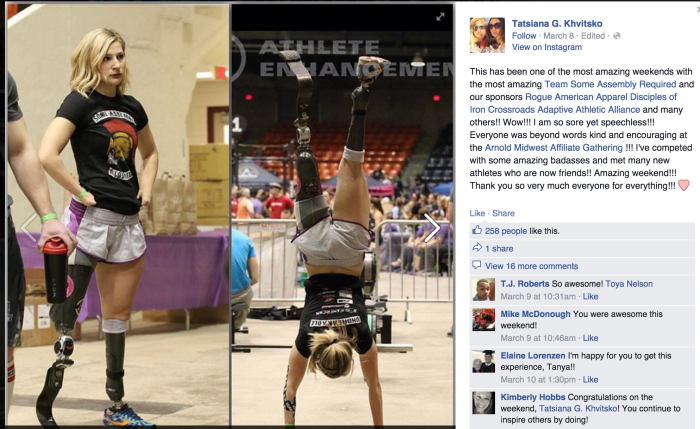From Belarus, Tatsiana is a congenital double amputee, due to the Chernobyl nuclear accident, and since being fitted with prosthetics she has competed in cross-fit and bodybuilding competitions. She has a huge passion and love for running! If you ask her why she runs, it’s simple—because she can!
Like many children born with deformities in the wake of the 1986 explosion, her parents abandoned her at an orphanage where she learned to walk on her knees. Aged six, US doctors flew her to Kansas City to fit her with prosthetic limbs.
Over the next 24 years, Tatsiana continued to defy the odds by becoming a competitive runner, cross-fit athlete and bodybuilder with thousands of adoring fans on social media.
Occupation: Graduate student
Three words that describe her: Passionate, unstoppable and thankful
<
Happy Tuesday, everyone!!! Please Help get me on the cover of Runner’s World by VOTING EVERY DAY. I need your vote! Thank you guys so very much!!! http://orm.la/6koif
Posted by Tatsiana G. Khvitsko on Tuesday, August 11, 2015

How running has changed her life:
I’ve always been an amputee and never knew what it’s like to run until four years ago. When I put on those running blades, I was running so fast—I felt like I was flying! Running gave me confidence, because I couldn’t hide my blade under pants! It made me realize that I am stronger and unstoppable!
She has completed two half-marathons and is planning to run a full marathon too. Wow, Tatsiana, you Go Girl!
The Chernobyl disaster (also referred to as Chernobyl or the Chernobyl accident) was a catastrophic nuclear accident that occurred on 26 April 1986 at the Chernobyl Nuclear Power Plant in Ukraine (then officially the Ukrainian SSR), which was under the direct jurisdiction of the central authorities of the Soviet Union. An explosion and fire released large quantities of radioactive particles into the atmosphere, which spread over much of the western USSR and Europe.
The Chernobyl disaster was the worst nuclear power plant accident in history in terms of cost and casualties. It is one of only two classified as a level 7 event (the maximum classification) on the International Nuclear Event Scale, the other being the Fukushima Daiichi nuclear disaster in 2011. The battle to contain the contamination and avert a greater catastrophe ultimately involved over 500,000 workers and cost an estimated 18 billion rubles. During the accident itself, 31 people died, and long-term effects such as cancers are still being investigated.













